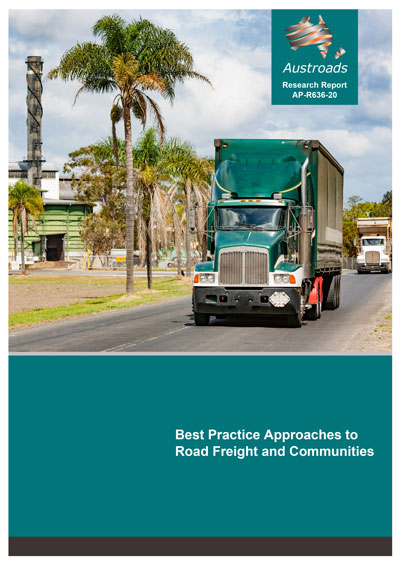Freight

- Publication no: AP-R636-20
- ISBN: 978-1-922382-29-0
- Published: 28 October 2020
- PDF (free) Download
Austroads commissioned project ‘Best Practice Approaches to Road Freight and Communities’ to develop guidelines for best practice strategies and supporting materials for state / territory and local government road managers to communicate the importance of freight with a particular focus on road freight. This was undertaken within the concept of a ‘social licence to operate’ which refers to the fostering and maintenance of community and stakeholder support for projects and operations.
A communications strategy encompassing three levels of campaigns was developed. The campaign “toolkits” are the guidance on the necessary steps to develop a campaign and communication tools to inform and engage the community on the importance of freight.
Tier One - Broad Campaign: A broad based national, state based or regional campaign with generic messages of the significance and value of freight. This level could work in collaboration with or input from the freight industry.
Tier Two - Localised Campaign: A more localised of specific campaign associated with freight issues such as a re-routing of trucks through an area or a proposed new route to be developed. It may cover several areas across a city or several regional towns.
Tier Three - Local Government Campaign: A campaign for local governments to use to inform on freight within a local municipality.
All three levels have common themes and objectives yet differ in delivery to meet the needs of the audience. They can work in unison or independent of each other.
- 1. Introduction
- 1.1 Background
- 1.1.1 Competing Modes of Rail and Road Transport
- 1.1.2 Road Freight Vehicle Composition
- 1.1.3 Emerging Need for Engagement
- 1.2 Purpose
- 1.3 Scope
- 1.3.1 Tier One – Broad Campaign
- 1.3.2 Tier Two – Localised Campaign
- 1.3.3 Tier Three – Local Government Campaign
- 1.3.4 Campaign Toolkit for Each Level
- 1.3.5 Campaign Implementation Template
- 1.4 Methodology
- 1.1 Background
- 2. Context and Issues
- 2.1 Background to Social Licence to Operate Concept
- 2.1.1 Defining Social Licence to Operate
- 2.1.2 The Origins of Social Licence to Operate
- 2.1.3 The Business Case for Social Licence to Operate
- 2.1.4 Recent Freight Industry Developments in Social Licence to Operate
- 2.2 Importance of Social Licence to Operate in Engaging Communities
- 2.2.1 Growth in Freight Industry Associated Externalities
- 2.2.2 Community Engagement
- 2.2.3 Community Resistance
- 2.2.4 The Loss of Community Support
- 2.3 The Impact of not having a Social Licence to Operate to Government and Industry
- 2.3.1 Impact on Infrastructure Projects
- 2.3.2 Impact on Government Decision Making
- 2.3.3 Impact on Industry Efficiency
- 2.4 Campaign Approach Considerations
- 2.1 Background to Social Licence to Operate Concept
- 3. Case Studies
- 3.1 FLCWA’s Social Licence to Operate Campaign
- 3.1.1 Observations on communication methods used:
- 3.2 Campania Regional Metro System Project
- 3.2.1 Observations on communication methods used:
- 3.3 Social Licence to Operate – Mining
- 3.3.1 Observations on communication methods used:
- 3.4 Improving Airport Community Relations
- 3.4.1 Observations on communication methods used:
- 3.5 Jandakot Airport Fly Neighbourly Protocol
- 3.5.1 Observations on communication methods used:
- 3.6 Social Marketing Perspective on Road Freight Transportation of Fruit and Vegetables
- 3.6.1 Observations on communication methods used:
- 3.1 FLCWA’s Social Licence to Operate Campaign
- 4. Consultation
- 4.1 Interviews
- 4.1.1 Key Messages
- 4.1.2 Promote Freight Positively
- 4.1.3 Communication Tools for Consideration
- 4.1.1 Key Messages
- 4.2 Survey
- 4.2.1 Questions Provided to Local Government
- 4.2.2 Points Raised by Local Government
- 4.2.3 Questions Provided to Industry
- 4.2.4 Points Raised by Industry
- 4.1 Interviews
- 5. Communications Strategy
- 5.1 Background
- 5.2 The IAP2 Spectrum of Public Participation
- 5.3 Three-Tiered Approach
- 5.4 Tier One (Broad Campaign)
- 5.4.1 Campaign Objectives
- 5.4.2 Research Questions
- 5.4.3 Research Approach
- 5.4.4 Campaign Strategy and Plan
- 5.5 Tier Two (Localised Campaign)
- 5.5.1 Campaign Process
- 5.6 Tier Three (Local Government Campaign)
- 5.6.1 Relationship with Tier One and Tier Two campaigns
- 5.6.2 Process
- 5.6.3 Critics
- 5.7 Summary of Communication Tools
- 5.8 Indicative Costs
- 5.9 Supporting Content Examples
- 5.9.1 Iconography
- 5.9.2 Public Relations
- 5.9.3 Marketing
- 6. Conclusions and Recommendation
- References
- Appendix A Local Government Campaign Implementation Template
- Appendix B Consultation – Interviews
- Appendix C Consultation – Survey Responses
- C.1 Local Government
- C.2 Freight Councils and Industry Organisations
- Appendix D Literature Review
- D.1 Background and Overview
- D.2 Public Engagement
- D.2.1 Overall Approach to Engagement
- D.2.2 Road Freight Public Engagement Tools and Approaches
- D.3 Government Approach to Engagement
- D.3.1 National Freight and Supply Chain Strategy
- D.3.2 Road Agency Communication Strategies
- Appendix E Road Agency Communication Templates
- E.1 South Australia Communications Plan Template
- E.2 Victoria Communications and Engagement Plan Template (Draft)
